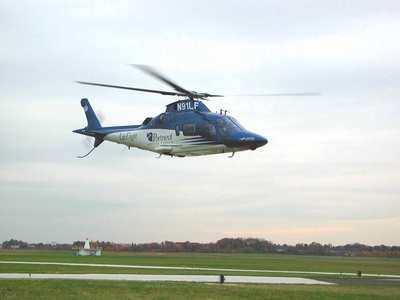Prompted By Discovery Of A Crack In A Main Rotor Blade
The FAA has issued an emergency AD (2015-22-51) for Agusta S.p.A. Model A109A and A109A II helicopters.

The Emergency AD was prompted by abnormal vibrations leading to a precautionary landing and a post-flight inspection finding of a crack in a main rotor blade (blade). The crack extended from the trailing edge to the rear face of the spar at the joint between the spar and the body of the blade.
The manufacturer’s maintenance program specifies inspecting each blade every 25 hours time in service (TIS). This Emergency AD requires checking and inspecting each blade for a crack. The checks are required before each flight and the inspections are required before further flight and then once each day. Replacing any cracked blade is required before further flight. The actions in this Emergency AD are intended to detect a crack in a blade and prevent failure of a blade and subsequent loss of control of a helicopter.
The European Aviation Safety Agency (EASA), which is the Technical Agent for the Member States of the European Union, has issued EASA AD No. 2015-0190-E, dated September 18, 2015, to correct an unsafe condition for the Agusta Model A109A and A109A II helicopters. EASA advises that abnormal vibrations were reported during a flight on a Model A109A II helicopter.
During a post-flight inspection, a crack was found on a part number (P/N) 109-0103-01-9 blade. EASA AD 2015-0190-E requires pre-flight inspections and repetitive inspections of each blade.
EASA advises that due to similarity of design, the inspections also apply to P/N 109-0103-01-7 and P/N 109-0103-01-115 blades. EASA advises that a cracked blade, if not detected and corrected, could affect the structural integrity of the blade, possibly resulting in blade failure and loss of control of the helicopter.
These helicopters have been approved by the aviation authority of Italy and are approved for operation in the United States. Pursuant to our bilateral agreement with Italy, EASA, its technical representative, has notified us of the unsafe condition described in the EASA Emergency AD. The FAA issuing this Emergency AD because we evaluated all information provided by EASA and determined the unsafe condition exists and is likely to exist or develop on other helicopters of these same type designs.
The Emergency AD requires for each blade P/N 109-0103-01-7, P/N 109-0103-01-9, or P/N 109-0103-01-115 that has 500 or more hours TIS:
Before further flight and thereafter at intervals not exceeding 24 clock-hours, using a 3X or higher power magnifying glass, visually inspecting the top and bottom surface of each blade for a crack in the area between the station at the end of the doublers and the station at the beginning of the abrasion strip. If there is a crack, before further flight, replacing the blade with an airworthy blade.
Before each flight, checking the top and bottom surface of each blade for a crack in the area between the station at the end of the doublers and the station at the beginning of the abrasion strip. This check may be performed by the owner/operator (pilot) holding at least a private pilot certificate and must be entered into the aircraft records showing compliance with this Emergency AD in accordance with 14 CFR §§ 43.9 (a)(1) through (a)(4) and 14 CFR 91.417(a)(2)(v). The record must be maintained as required by 14 CFR §§ 91.417, 121.380, or 135.439. This check is an exception to our standard maintenance regulations. If there is a crack, the blade must be inspected using a 3X or higher power magnifying glass.
The FAA considers this Emergency AD to be an interim action. If final action is later identified, the agency might consider further rulemaking then.
(Image from file)
 Affordable Flying Expo Announces Industry MOSAIC Town Hall
Affordable Flying Expo Announces Industry MOSAIC Town Hall Classic Aero-TV: Composite-FX Sets Elevates the Personal Helicopter Market
Classic Aero-TV: Composite-FX Sets Elevates the Personal Helicopter Market Aero-News: Quote of the Day (10.25.25)
Aero-News: Quote of the Day (10.25.25) ANN's Daily Aero-Term (10.25.25): Ground Stop (GS)
ANN's Daily Aero-Term (10.25.25): Ground Stop (GS) NTSB Final Report: Gallow Daniel A Kitfox Classic IV
NTSB Final Report: Gallow Daniel A Kitfox Classic IV



